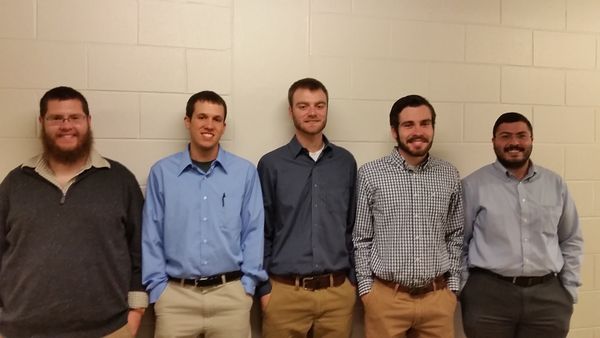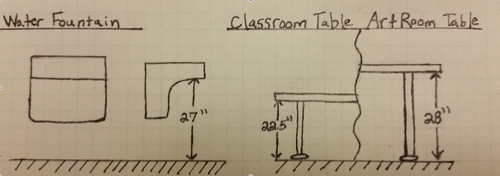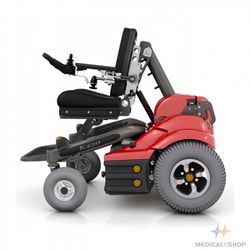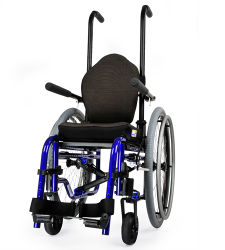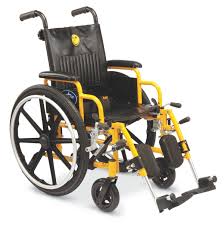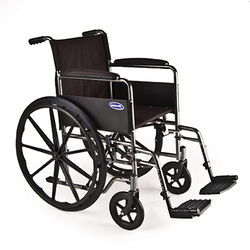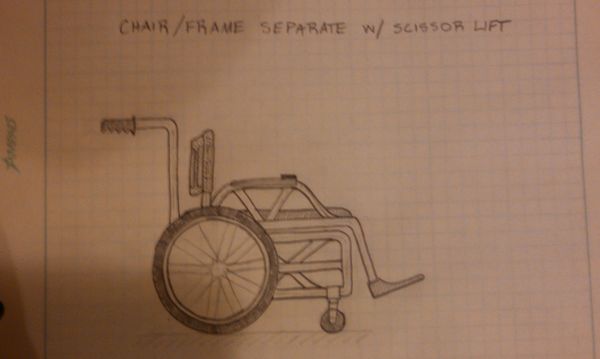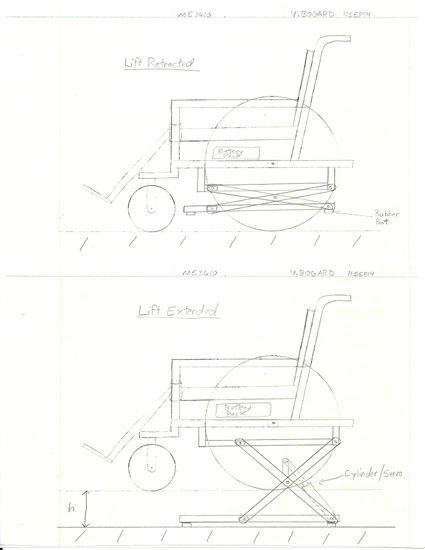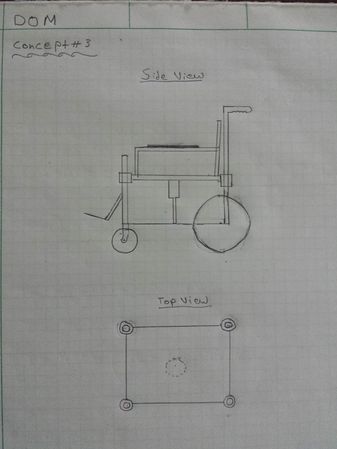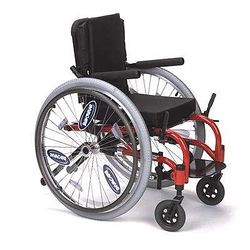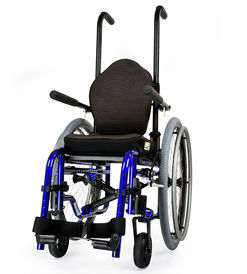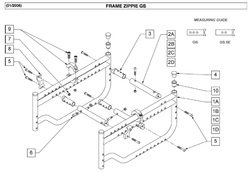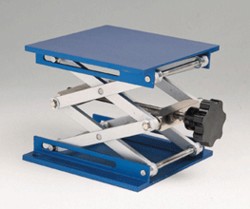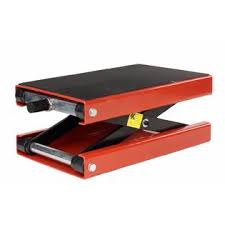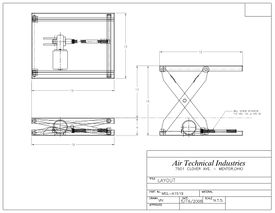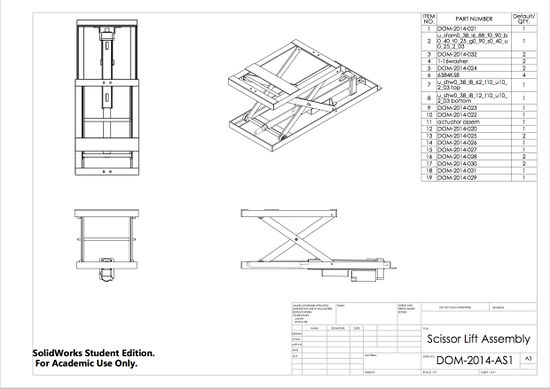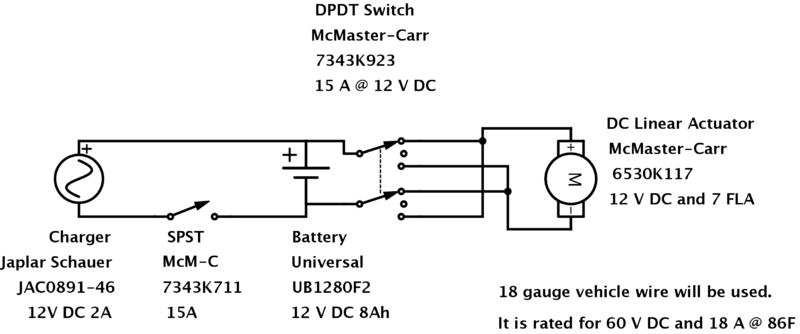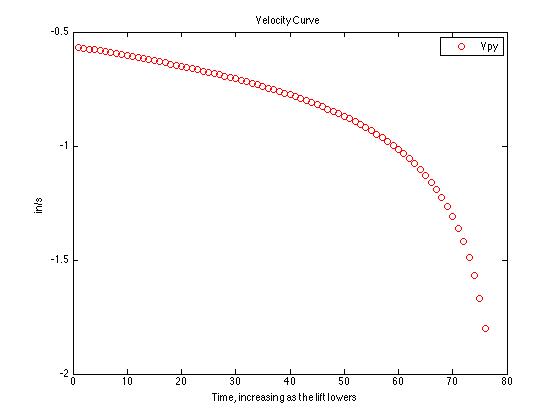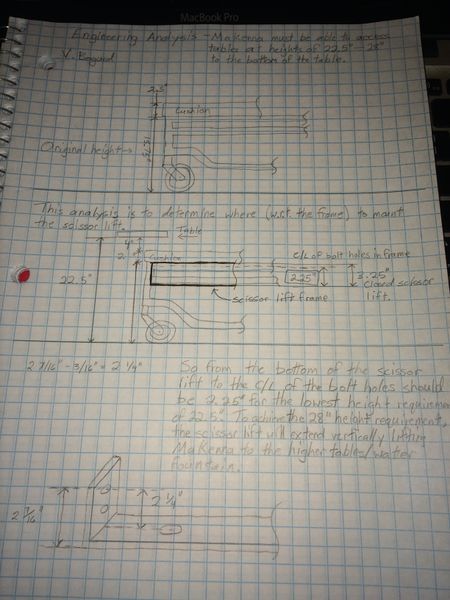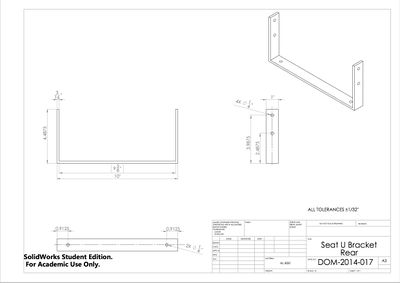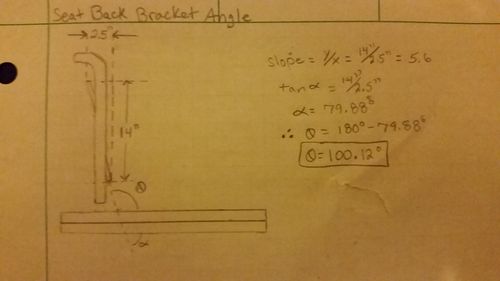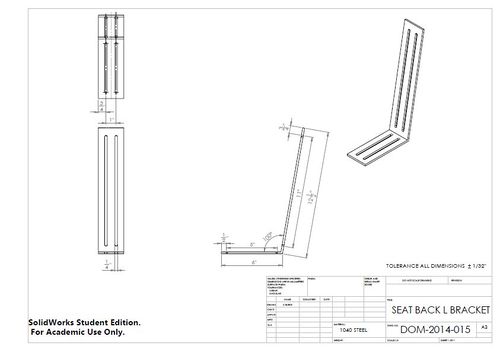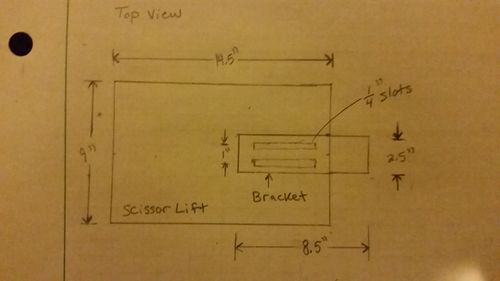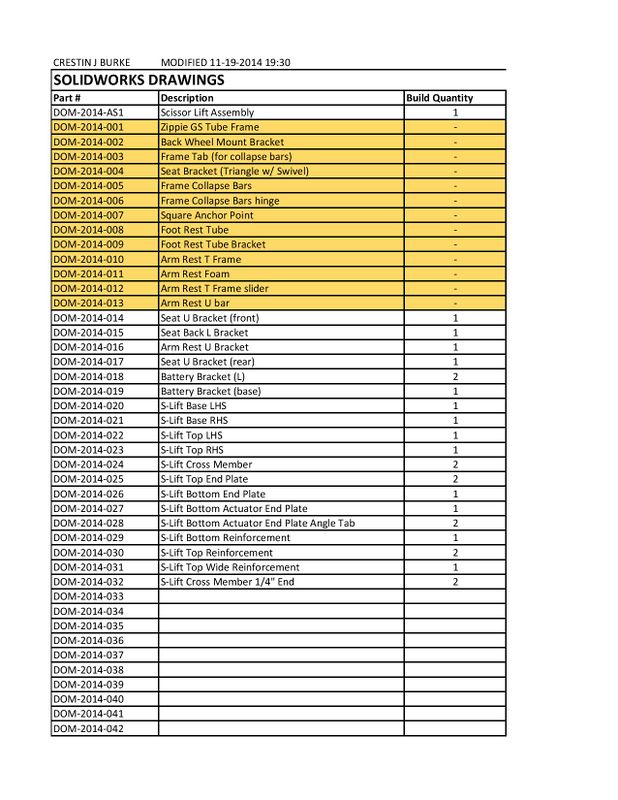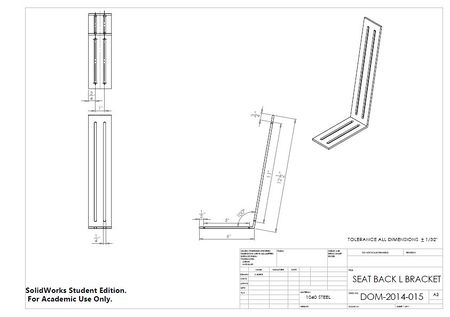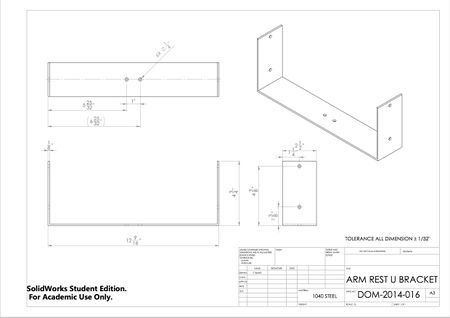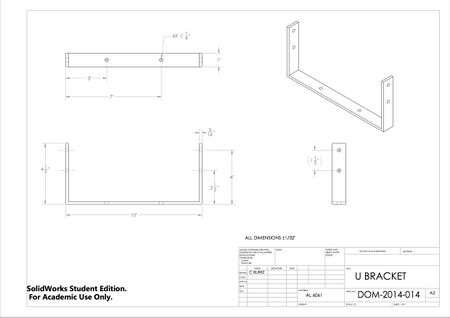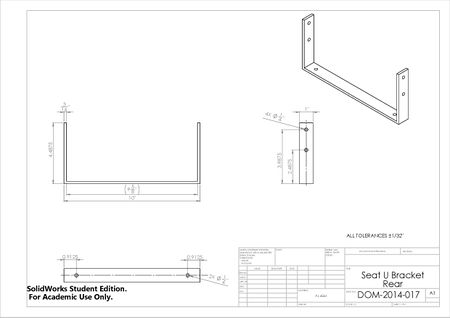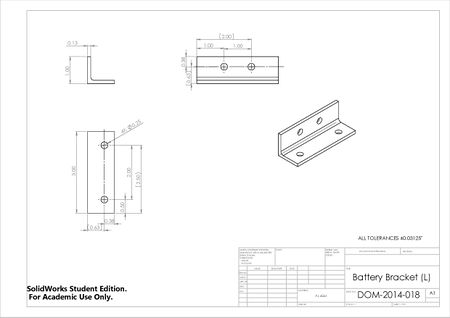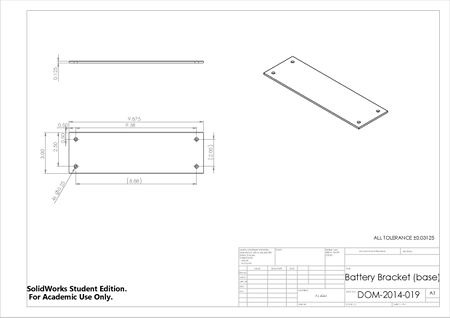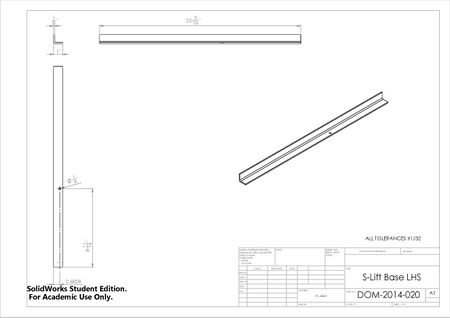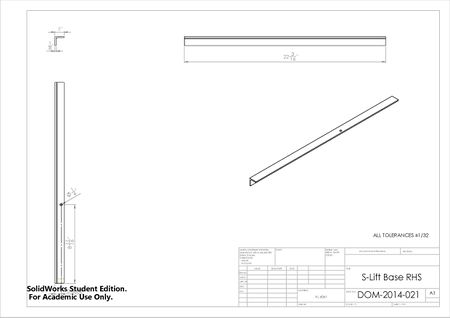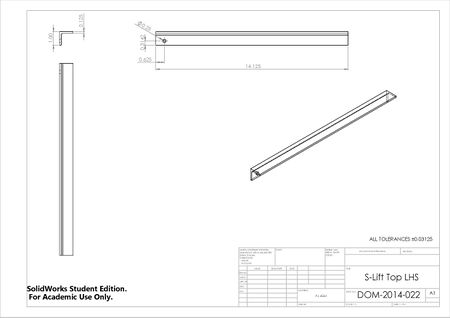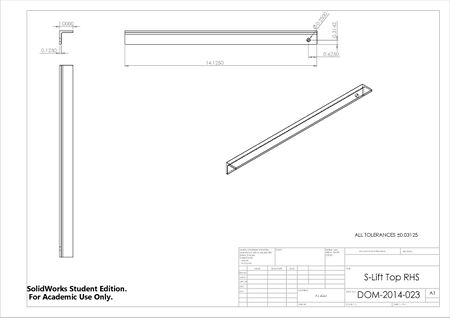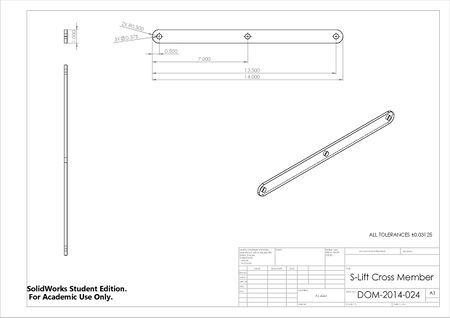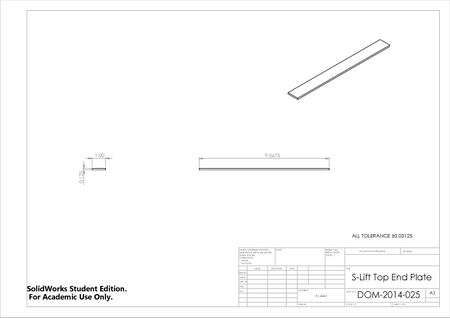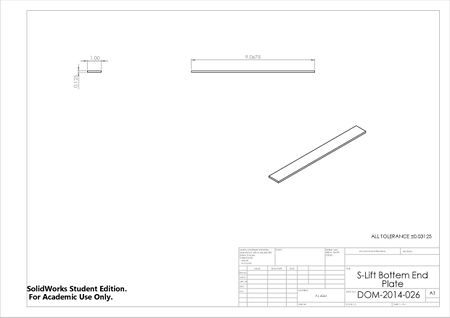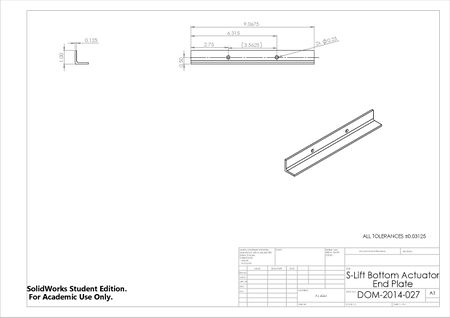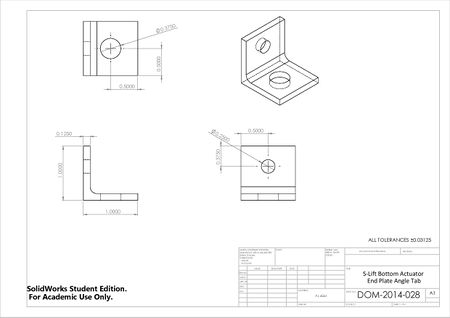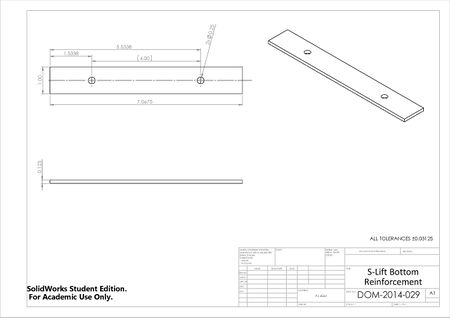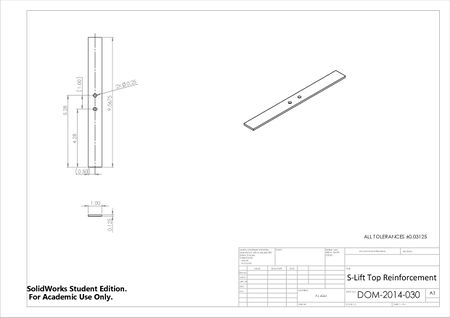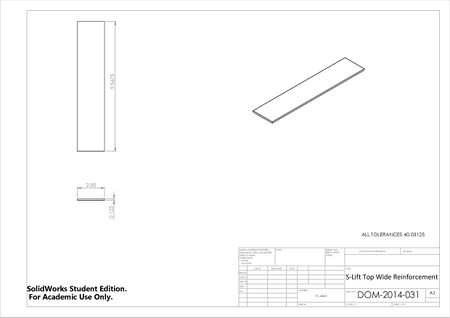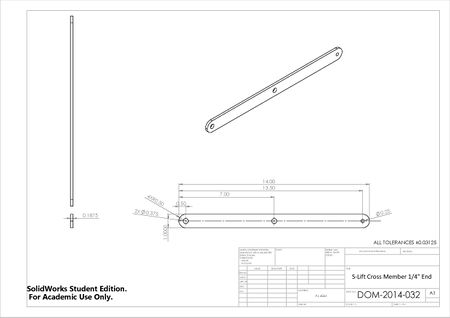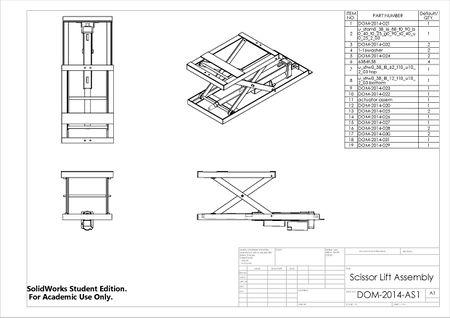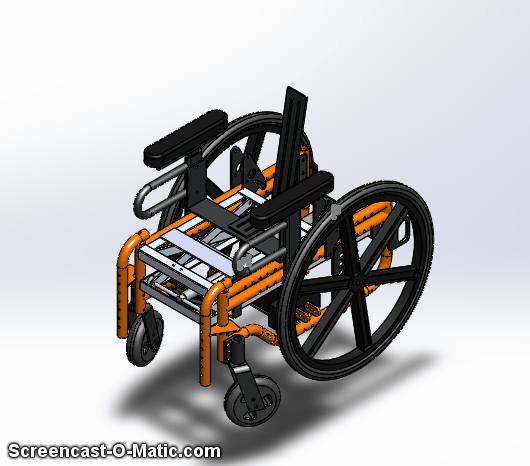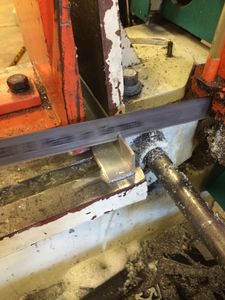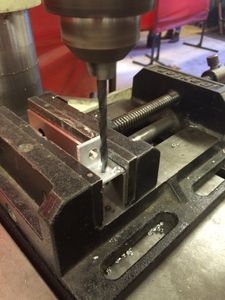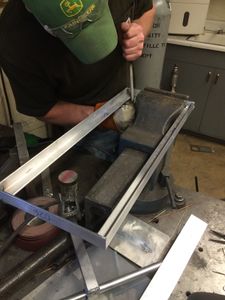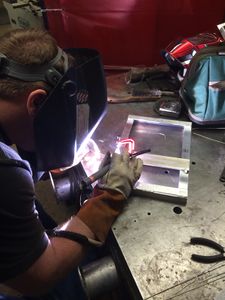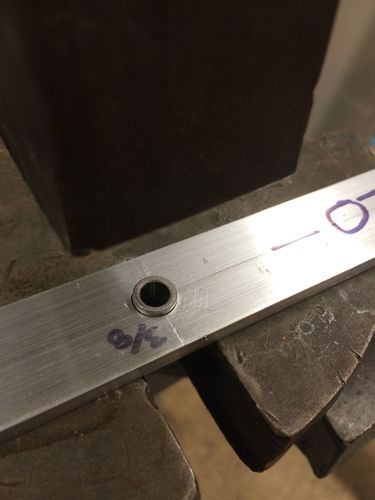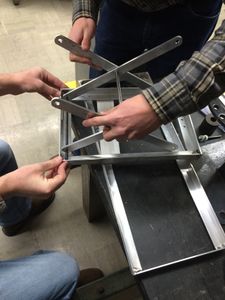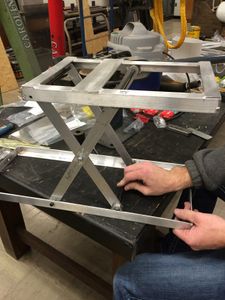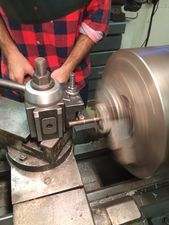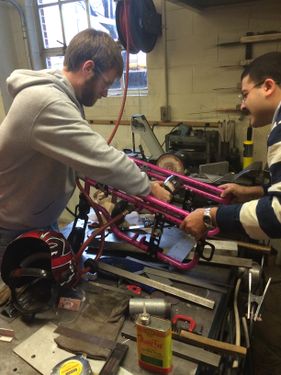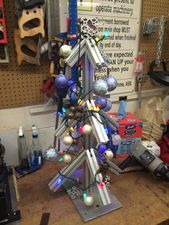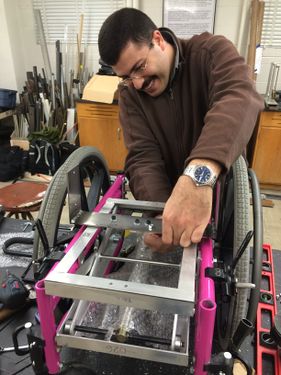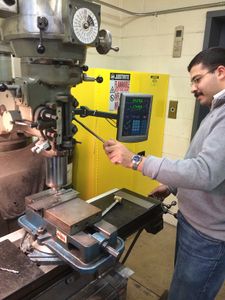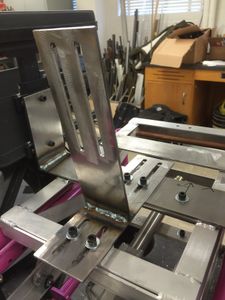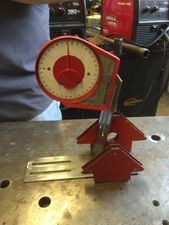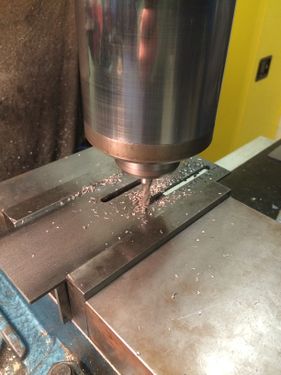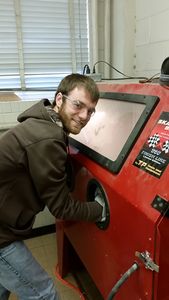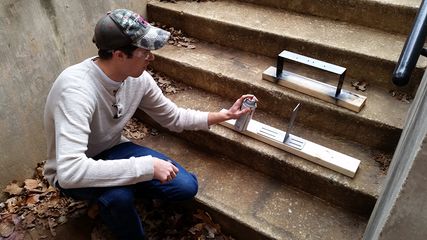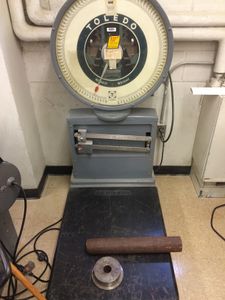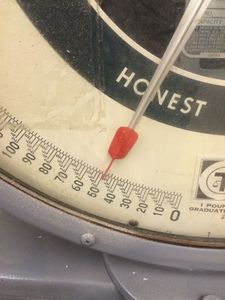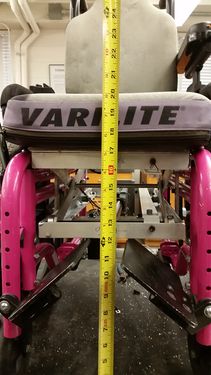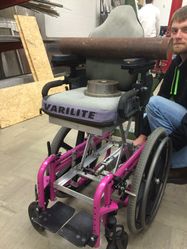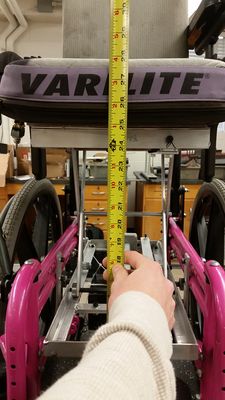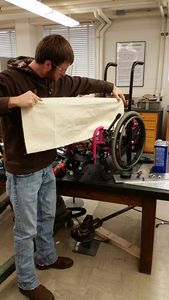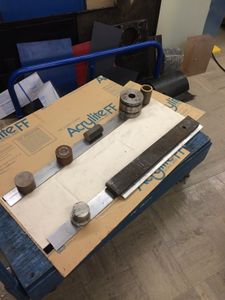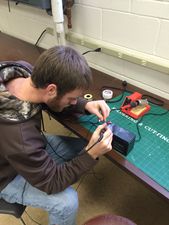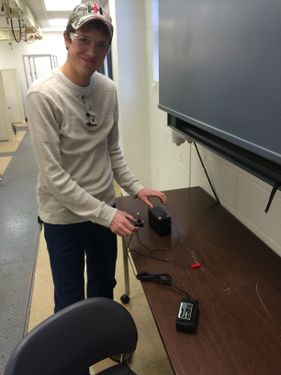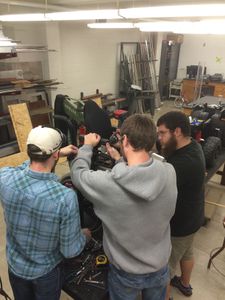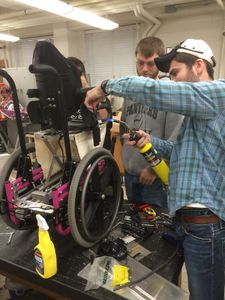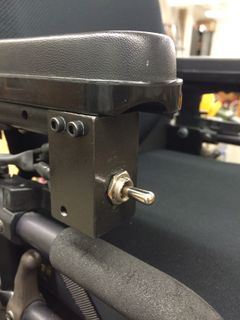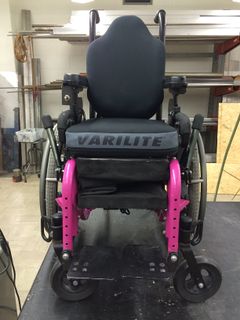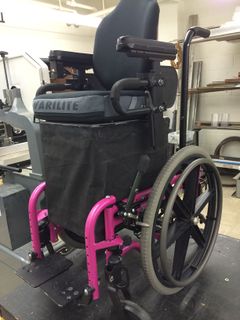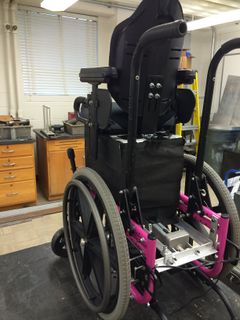Wheelchair Accessibility F14
Contents |
Abstract
Makenna, a 5-year-old with Spina Bifida, does not have mobility below her waist. She cannot access the water fountain and certain tables at school without assistance.
Team members
- Will Ripley
- Vance Bogard
- Justin Waldo
- Crestin Burke
- Abanoub Riyad
Problem Statement
Makenna needs to have access to the water fountain and tables at school. Our plan is to design and build a wheelchair for Makenna that will raise and lower depending on her height needs. The wheelchair that they have now is heavy and difficult to move, so the wheelchair that we provide will stay at her school for her to use there.
Background Research
| Permobile K450 | Zippie GS | Excel Kidz | Invacare Veranda | |
|---|---|---|---|---|
| Advantages | No modification required for raise/lower and has a 17-mile battery life. | This is her current wheelchair. | Much cheaper than any other options new. | Basic design and affordable. |
| Disadvantages | Electrically propelled, therefore operator would not use upper body strength. | Will require modification the the wheelchair. | Weights 5 lbs more than the Zippie GS | 40 lbs does not have adjustable seat options. |
| MSRP $ | $11,737 | $1,875 | $309 | $99 |
| Used $ | $4,999 | $235 | $175 | $35 |
| Lead Time | 14 Days | 5-10 Days | 2-3 Days | 1-2 Days |
The only vertically translating wheelchairs currently on the market also have electrically powered wheels. One of our design requirements necessitates that Makenna supply the power to the wheels. Mechanisms currently used to raise wheelchair seats include: scissor lift style and floor jack style as seen below.
We could not find any intermediate designs between fully automatic and fully manual styles. This makes it necessary for us to design a hybrid that will raise and lower but also allow Makenna to maintain upper body mobility by requiring her to provide the power to the wheels.
Build from scratch vs. buy and adapt
Building our own wheelchair from scratch would allow us to completely control the design, however fabrication would be difficult and time consuming. Purchasing a wheelchair that we already know fits Makenna and adapting it to her needs proves to be a more logical solution.
Preliminary Design Specifications
1) Translate in the vertical direction 8-10 inches
2) Power source must be mobile and quiet (<85dB at 3 ft)
3) Stable - Makenna must be able to lean left, right, forward and back in the seat without the chair tipping when raised to max height
4) Must have intermediate height positions in, at most, 1 inch increments
5) Weight must not exceed ~ 50 lbf
6) Maintain upper body mobility - the horizontal power for the wheelchair should still be provided by Makenna
7) Easy access - Makenna into and out of chair easily
8) Max and min seat height - 20" and 28"
9) Power source must be low maintenance
Ideas for Raising and Lowering Mechanism
1) Air Bag
- Pros: Will raise and lower with infinite increments, Lightest option as far as lifting apparatus, Almost no risk of pinch points
- Cons: Air compressor is loud and very heavy, High risk of puncture that could render the air bag useless, Possibility of loosing air pressure
2) Pneumatic cylinder
- Pros: Will raise and lower with infinite increments, Low risk of pinch points
- Cons: Air compressor is loud and very heavy, Possible alignment issues, Chair could fall if air pressure totally drops, Possibility of losing air pressure
3) Pneumatic scissor lift
- Pros: Minimal alignment issues, Will raise and lower with infinite increments, Can be mounted in multiple positions on the wheel chair
- Cons: Air compressor is loud and very heavy, Possibility of introducing pinch points if not properly guarded, Possibility of loosing air pressure
4) Electric scissor lift
- Pros: Quieter propulsion system, Can raise and lower with infinite increments, Can be mounted in multiple positions, Minimal alignment issues
- Cons: Electric battery could run out, Could introduce pinch points if not properly guarded
5) Electric cylinder
- Pros: Can raise and lower with infinite increments, Quiet, Low risk of pinch points
- Cons: Battery could run out of charge, Possible alignment issues,
6) Hand powered bottle neck jack
- Pros: Relatively light weight, Raises and lowers with minimal "fixed" increments, Human powered (no external power source necessary)
- Cons: Could cause fatigue in operator, Could introduce possible pinch points
7) Hand powered air filled cylinder
- Pros: Can raise and lower with many minimal "fixed" increments, Human powered
- Cons: Could cause fatigue in operator, Possible alignment issues,
8) Hydraulic pump
- Pros: Will raise and lower with infinite increments, Quiet
- Cons: Messy, Difficult to maintain, Heavy
9) Lab Jack
- Pros: Light weight, Easiest to maintain, Can use either operator power or electric/pneumatic motor
- Cons: Introduces possible pinch points
Conceptual Designs
All of the following designs are based on purchasing a fully manual wheelchair and modifying it to fit Makenna's needs.
Concept 1
The bottom frame will remain in contact with the ground, and the chair will raise independently. The scissor lift mechanism will be the interface between the two frames.
Pros:
A) Can raise and still be mobile
B) More versatile than Concept 2
C) Can slightly adapt seat for growth
Cons:
A) Heavier than current
B) More difficult to safeguard against pinch points, etc.
C) More difficult to design than other concepts
Concept 2
Concept 2 has the lifting mechanism mounted below the seat of the wheelchair. When Makenna needs to raise up she will stop, lock the wheels on her wheelchair and activate the electric servo cylinder which will raise her whole chair up by means of a scissor lift mechanism
Pros:
A) Fewer possible pinch points than other concepts - mechanisms are internal to wheelchair
B) Will have starting point for fabrication
Cons:
A) Lacks mobility when in raised position
B) Would need Poka-yoke against battery dying
C) May not be able to use Makenna-power (the operator supplies the power to raise and lower)
Concept 3
Similar to Concept 1 with base frame and seat frame. Instead of using a scissor lift mechanism, four linear slides will be mounted on the four corners of the chair frame. A vertical cylinder, mounted in the center of the seat frame, will supply the lifting force.
Pros:
A) Lower pinch point potential
B) Simplest option (no scissor lift mechanism)
C) Can use electric or operator supplied power
Cons:
A) Possibility of misalignment issues with four sliders
B) Similar design/fabrication difficulty to Concept 1
Evaluate concepts/select candidate
| Concept 1 | Concept 2 | Concept 3 | |
|---|---|---|---|
| Mobility | 5 | 1 | 5 |
| Alignment Issues | 3 | 3 | 1 |
| Fabrication Difficulty | 3 | 3 | 2 |
| Ease of Use | 5 | 2 | 5 |
| Reliability | 4 | 4 | 3 |
| Cost | 3 | 4 | 3 |
| Weight | 4 | 3 | 4 |
| Stability | 4 | 5 | 4 |
| Durability | 4 | 4 | 3 |
| Total Points | 35 | 29 | 30 |
| Possible Points | 45 | 45 | 45 |
| % Total | 77.8% | 64.4% | 66.7% |
The decision matrix above led us choose Concept 1 as our winning design. Concept 1 proves to be the most promising option because it allows for mobility in the vertical and horizontal directions while at the same time utilizing a more reliable raising mechanism.
Detailed Design
Description of selected design
The design we selected, concept 1, consists of a base frame, scissor lift mechanism, drive system and seat frame. The base frame remains in contact with ground and provides a foundation from which to raise the user. The lifting mechanism - a scissor lift - is the interface between the base frame and the seat frame. The seat frame must have at least armrests and a back support. The drive system simply provides the force needed to raise and lower the seat and user.
Detailed description of selected design
Wheelchair Frame
Design concept 1 requires us to select a pediatric wheelchair to modify. Compared to other pediatric wheelchairs like the Top End Terminator Jr. or the Excel Kidz, the Zippie GS proves to be the best choice for the following reasons:
- Symmetric, square style frame that will provide sufficient mounting points for the scissor lift mechanism
- The Zippie GS frame has already been designed with adjustment/different configuration capability
- Makenna already uses this model of wheelchair, so we know that the wheelchair seat, armrests and footrests will fit her well
- Arm rests are not an integral part of the base frame like the Excel Kidz
- Cost is comparable to other quality pediatric wheelchairs
- The therapist agrees that this is a good direction because she already uses the Zippie GS and it works well for her
Top End - Terminator Jr.
Lifting Mechanism
| 2 Stage Lab Jack | LD-M1101 | MSLA 1519 | |
|---|---|---|---|
| Length | 9" | 14.5" | 19" |
| Width | 9" | 9" | 15" |
| Max Height | 10" | 13.25" | 16" |
| Min Height | 3" | 3.25" | 4" |
| Price | $165 | $75 | -- |
| Lead Time | 14 days | 5 days | -- |
After researching a number of scissor lift style lifting mechanisms as well as exploring the idea of designing and building a custom lift mechanism, we found that building our own would be the best option. We originally thought that the Dragway Tools 1100 lbf jack would be perfect. It was the exact size we needed to fit inside the frame and it met our requirements for lifting height. However, the jack weighs about 30 pounds which is unaceptable. We can control the weight, the lifting height, and the size of the lift if we design our own. So, we decided to build a lift. Below is the assembly drawing of the aluminum scissor lift assembly driven by a linear electric actuator.
Drive Units
| Electric Actuator | Air Cylinder | Hydraulic Cylinder/Jack | Ballscrew/ACME screw | |
|---|---|---|---|---|
| Pros | quiet, lightweight, no fluids | force to weight ratio is high, simple config | quiet | can utilize electric or manual power, quiet, light, low maintenance |
| Cons | needs battery and charger | requires air compressor and tank, noisy | fluid system maintenance, leakage, heavy, requires numerous valves | not compact-length maybe an issue (motor extends past shaft) |
| Price ($) | 430 | 280 | 400 | 150 |
The selected drive unit is a 12 V DC linear actuator supplied by McMaster-Carr. The actuator will pull 7 amps at full load, which corresponds to a force of 250 lbf. The part number is 6530K117.
Power Sources
The therapist has requested that we not design a wheelchair that will require Makenna to provide the lifting power so that she does not get tired.
Assumptions:
- The maximum time that Makenna will spend per day in the process of raising/lowering is 1 hour.
- The wheelchair will be able to be charged every night
The selected power source is a 12 V DC batter from Universal (UB1280F2) with 8 Ah capacity. This is a compact battery which also relatively light at 6 lb. See engineering analysis 1 for additional configuration details.
Analysis
The first engineering analysis contains the details of the circuit that will contain the battery, switch and motor that will drive the scissor lift mechanism of the wheelchair.
The second engineering analysis shows the dimensional analysis that provided the mounting location of the lift mechanism to the wheelchair frame such that the three table height requirements shown above can be met.
The third engineering analysis was performed on the bracket that mounts the seat back to the lifting mechanism.
Engineering analysis 1
Electrical Circuit Design
1. The linear actuator selected has a max force of 250 lbf. At full load it pulls 7 amps. 0.4 in/s is the actuator speed. With this speed, the plot below shows the actual velocity of the seat as the scissor lift lowers from its fully raised position to the fully lowered position.
2. The power source chosen to supply the motor is a 12 V DC Sealed Lead Acid battery. The capacity of this battery is 8 Ah. With a motor that pulls a maximum of 7 A, this battery will be capable of running the motor for a minimum of 1.14 hours on a single charge. The specs are as follows: weight = 6.0 lb, length = 5.95", width = 2.56", height = 3.70".
3. To connect the power source to the drive motor a 3 position toggle switch will be used. This switch will carry 15 A at 12 V DC. It has 6 terminals and is momentary rocker style so it will automatically return to center (off) when released.
4. Wiring used to connect circuit components will be 18 gauge PVC coated vehicle wiring capable of carrying 17 A @ 86F.
5. To charge the battery, a 12V 2A automatic start charger will be used. If the battery is completely depleted, it will only take 4 hours to charge the battery (8 Ah/2 A = 4 hours). This charger is lightweight and compact and will be mounted on the wheelchair so that the wheelchair can be plugged in to charge overnight and used during the day.
Engineering analysis 2
This analysis was key in our design of the brackets that will be used to mount the scissor lift mechanism to the frame. Makenna must be able to access tables at heights of between 22.5 and 28 inches to the bottom of the table (or water fountain). As shown in the picture, to leave a 4" gap between the seat cushion and the bottom of the lowest table, the distance between the centerline of the bolt holes in the upper frame bar and the bottom of the scissor lift must be 3.8". The scissor lift mechanism we designed has a closed height of 5". The bracket will be made of 3/16" thick flat aluminum as shown.
^ Preliminary design, dimensions not current ^
The scissor lift will extend, allowing Makenna to access taller tables and the water fountain at school.
Engineering analysis 3
The seat back bracket was designed to allow the backrest to translate vertically with the scissor lift. This will allow Makenna to have back support at any given position. The challenge in this design was to keep the seat in the current orientation, and still allow for translation and stability. We also designed this bracket so that it will be able to be adjusted to fit Makenna's needs as she grows.
CAD Drawings
Bill of Materials
| Item Description | Quantity | Source | OEM | Part Number | Price | Lead Time |
|---|---|---|---|---|---|---|
| Wheelchair | 1 | Ebay | Quickie | Zippie GS | $200 | 7 days |
| Cross Shafts for Lift Mechanism | 1 | Misumi | Misumi | U-SFRW0.25-L9.56-T5-U5 | $37.40 | 7 days |
| Battery for Motor | 1 | Batterywholesale.com | Universal Batteries | UB1280F2 | $14.50 | 5 days |
| Battery Charger | 1 | Batterystuff.com | Japlar Schauer | JAC0891-46 | $52 | 4 days |
| 3 Pos. Toggle Switch | 1 | McMaster-Carr | McMaster-Carr | 7343K923 | $23.65 | 3 days |
| Seat Cushion Cover | 1 | Caremedicalsource.com | VARILITE Zoid | 04652 | $61.50 | 8 days |
| Back Cushion Cover | 1 | Caremedicalsource.com | VARILITE | 04637 | $63 | 8 days |
| Wiring for Motor Circuit-12 ga. vehicle wire | 45 ft. | McMaster-Carr | McMaster-Carr | 6659T58 | $5.60 | 2 days |
| 1/8" x 2.5" Steel Flat Bar | 6 ft | McMaster-Carr | McMaster-Carr | 8910K401 | $22.67 | 2 days |
| Paint | 1 can | O'reilly Auto parts | O'reilly Auto parts | HVP104 | $8.22 | N/A |
| 1/8" Aluminum Angle | 12 ft | McMaster-Carr | McMaster-Carr | 8982K4-12ft | $29.97 | 3 days |
| 1/8" x 1" Aluminum Flat Bar | 6 ft | McMaster-Carr | McMaster-Carr | 8975K578-6ft | $6.53 | 3 days |
| 3/16" x 1" Aluminum Flat Bar | 6 ft | McMaster-Carr | McMaster-Carr | 8975K586-6ft | $17.80 | 3 days |
| 1/8" x 2" Aluminum Flat Bar | 6 ft | McMaster-Carr | McMaster-Carr | 8975K582-6ft | $11.35 | 3 days |
| 1/8" x 3" Aluminum Flat Bar | 1 ft | McMaster-Carr | McMaster-Carr | 8975K83-1ft | $3.75 | 3 days |
| 3/16" x 2.5" Steel Flat Bar | 3 ft | McMaster-Carr | McMaster-Carr | 8910K538-3ft | $17.87 | 3 days |
| Linear Actuator | 1 | McMaster-Carr | McMaster-Carr | Linear Actuator | $428.75 | 4 days |
| Cross Shaft Short | 1 | Misumi | Misumi | Cross Shaft Short U-SFRW0.38-L8.12-T10-U10 | $26.62 | 9 days |
| Cross Shaft Long | 1 | Misumi | Misumi | Cross Shaft Long U-SFRW0.38-L8.62-T10-U10 | $37.40 | 9 days |
| Bearing Rollers | 4 | McMaster-Carr | McMaster-Carr | 6384K58 | $34.76 | 2 days |
| Plexiglass Sheet 12"x24" 1/8" thick | 1 | McMaster-Carr | McMaster-Carr | 8560K257 | $15.67 | 3 days |
| Center Shaft | 1 | Misumi | Misumi | Center Shaft U-SFAM0.38-L6.88-F0.9-B0.4-T0.25-G0.9-S0.4-U0.25 | $32.46 | 9 days |
| Bushing | 8 | McMaster-Carr | Mcmaster-Carr | 2868T1 | $6.08 | 2 days |
| Bushing | 4 | McMaster-Carr | Mcmaster-Carr | 2868T47 | $2.48 | 2 days |
| Spacer | 1 | McMaster-Carr | Mcmaster-Carr | 92678A441 | $8.49 | 2 days |
| Spacer | 2 | McMaster-Carr | Mcmaster-Carr | 92415A457 | $6.04 | 3 days |
| Spacer | 2 | McMaster-Carr | Mcmaster-Carr | 92415A446 | $5.06 | 3 days |
| Velcro | 10ftx1in | McMaster-Carr | Mcmaster-Carr | 9273K21 | $13.50 | 2 days |
| Canvas | 1 yard | Hobby Lobby | Hobby Lobby | In Store Purchase | $12.00 | N/A |
| Miscellaneous Hardware | $50.00 | N/A | ||||
| Total | - | - | - | - | $1256.12 |
The seat cushion cover is 12" x 12" and the fabric is "incontinence". The back cushion cover is 12" tall.
Fabrication Process
| Actuator Tab | Frames | Cross Members |
|---|---|---|
| |
|
|
| Vance cutting and drilling the actuator mounting tabs | Seth welding the seat frame | Pressing the bushings into the center hole of the cross members |
| Scissor Lift | Actuator Pin and Frame | Christmas Decor and Arm Rest Bracket |
|---|---|---|
| |
|
|
| Crestin and Vance assembling the scissor mechanism | Turning slots in the actuator mounting pin for snap rings and Justin cutting tabs off of the frame - yikes! | Christmas cheer in the shop and Abanoub having fun mounting the armrest bracket! |
| Steel Brackets | Steel Brackets Cont'd | Sandblasting and Painting |
|---|---|---|
| |
|
|
| Abanoub on the mill cutting slots for the steel brackets - armrest and seat back | Setting the bracket angle to 100 degrees before welding | Justin sandblasting and Vance painting |
| Weight Testing | Weight Testing Cont'd | Checking the Heights |
|---|---|---|
| |
|
|
| We tested the the functionality of the wheelchair with the maximum capacity of 50 lbf | We verified that the design requirement heights could be met with the current vertical stroke configuration. |
| Safety Guarding | Circuit Work | More Circuit Work |
|---|---|---|
| |
|
|
| Justin working on the safety skirt | It's never good when ME's try to be electricians | Mounting the switch bracket and heat shrinking the connections. |
Photos of Completed design
See this video for a dynamic view
Scissor Lift Wheelchair - Tennessee Tech University
See this video for the maximum weight capacity testing
Instructions for safe use
Do not use the device unless supervised by an adult that has been fully trained in the safe use of this product.
See User Manual below. Click on the link and select most recent version:
File:Wheelchair User Manual.zip
File:Wheelchair User Manual 2.zip
Summary and Conclusions
Overall this project was great!
Designing the scissor lift mechanism was somewhat tedious at times. After looking at many different design concepts, we decided to proceed with designing and building our own custom scissor lift mechanism. It was designed using Solidworks modeling software. From here the design was analyzed on paper and with MATLAB programs. Once it was all finalized it was time to start fabricating. Fabrication went smoothly since we had a very accurate 3D model from which to generate part drawings. The assembly process was also very smooth, and we only encountered minor issues during assembly. After mounting the scissor lift assembly into the frame and bolting on the steel brackets, we felt like the project was almost complete, however there were a number of other details to complete. Brackets were sandblasted then painted, the electrical circuit was completed and the safety covering was installed.
We had a blast designing, fabricating, and assembling this wheelchair. All of us learned a lot from the hands on experience. Getting to provide a product that will help Makenna at school has been very rewarding.
We are extremely excited to present this to Makenna and see her reaction!
